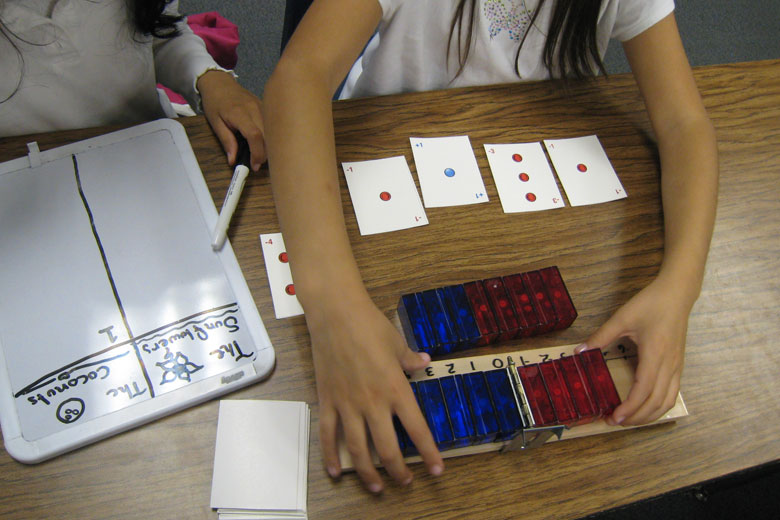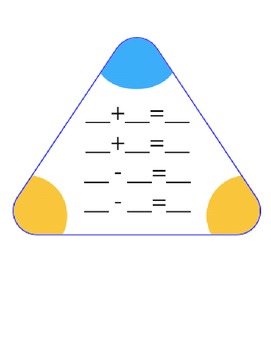Best Ca Common Core Site for Math Review
8 Popular Common Core Math Standards Explained with Examples in the Classroom
All Posts
Prodigy offers Common Core-aligned math exercise that your students volition beloved. Start today!
Beginning in 2010, the Common Cadre Land Standards Initiative (CCSSI) aimed to modify the way American students were taught English language arts and mathematics by countering low examination scores, inconsistent learning standards and a curriculum that was a "mile wide and an inch deep." Of the 45 states (plus the District of Columbia and the Section of Defense Instruction Activity) that fully implemented Common Core past 2015, 24 chose to revise some aspects of the program but however remain aligned with the original standards today.
What is Common Cadre math?
 The Common Core State Standards for Mathematical Do were designed to reform the American didactics system, with 3 main goals:
The Common Core State Standards for Mathematical Do were designed to reform the American didactics system, with 3 main goals: - Provide graduating high school students with the skills they need to be successful either in the workforce or in postal service-secondary pedagogy
- Boost math test scores for all American students
- Smooth out the differences between individual country curriculums and practices
- Make sense of problems and persevere in solving them
- Reason abstractly and quantitatively
- Construct feasible arguments and critique the reasoning of others
- Model with mathematics
- Employ appropriate tools strategically
- Attend to precision
- Look for and make use of structure
- Wait for and express regularity in repeated reasoning
Is Common Core math working?
Due to the massive overhaul of country education frameworks, many teachers are still scrambling to prepare. A report from the Heart for Education Policy Research at Harvard University reported that 82% of math teachers are changing "more than half of their instructional materials" in response to the new practice standards. The aforementioned study found that "three out of four teachers (73%) reported that they take embraced the new standards 'quite a scrap' or 'fully'." Source: Middle for Education Policy ResearchCommon Cadre is a radically new framework for teachers, and many older resources are no longer relevant. If yous're nevertheless working to adjust, this post is for you. You lot'll discover:
Source: Middle for Education Policy ResearchCommon Cadre is a radically new framework for teachers, and many older resources are no longer relevant. If yous're nevertheless working to adjust, this post is for you. You lot'll discover: - Definitions for each of the eight standards
- Examples to help you seamlessly incorporate each standard into your classroom
- Suggestions for talking to parents almost the new Common Core math curriculum
1. Make sense of bug and persevere in solving them
When students approach a new problem for the first time, they might be tempted to go directly for the solution. After all, isn't that the indicate? The commencement standard directly counters this impulse. When students rush in to immediately solve a problem, they often fail to understand the underlying concepts. Rote memorization and a quick recall are essential parts of mathematical fluency, but tin can ofttimes pb to greater problems. If a educatee doesn't understand the underlying concept behind the facts they've spent time learning, they might struggle with more complicated problems or ideas. Giving students more than open up-ended questions or methods allows them to work with the concepts backside the trouble, instead of going straight to the solution. For example, expect at this typical Common Cadre math problem: Source: The School RunWhile it looks complicated, a number line is a Common Cadre math example that teaches students several essential concepts:
Source: The School RunWhile it looks complicated, a number line is a Common Cadre math example that teaches students several essential concepts: - The relationship between numbers in a given trouble
- The potential for more than than ane solution
- The foundation backside shortcuts and more than complex processes
Case:
Jennifer Smith and Michelle Stephan used this question to contain the outset standard into a seventh-grade classroom: Source: Journal of the American Academy of Special Education ProfessionalsThe problem was presented to the class with a quick introduction, and the teachers asked students to observe the greater net worth -- without explaining how. Students worked alone or in groups to discuss the question and their process, while the teachers supervised and made note of dissimilar strategies. The teachers spent minimal time with the students, fixing only minor mistakes and encouraging them to work with their group. Every student was actively engaged in working with the problems, and explained their thinking to the class in a follow-upwardly discussion.
Source: Journal of the American Academy of Special Education ProfessionalsThe problem was presented to the class with a quick introduction, and the teachers asked students to observe the greater net worth -- without explaining how. Students worked alone or in groups to discuss the question and their process, while the teachers supervised and made note of dissimilar strategies. The teachers spent minimal time with the students, fixing only minor mistakes and encouraging them to work with their group. Every student was actively engaged in working with the problems, and explained their thinking to the class in a follow-upwardly discussion. 2. Reason abstractly and quantitatively
 There are two parts to the 2d standard: decontextualization and contextualization. Decontextualization refers to the process of understanding the symbols in a problem as separate from the whole. This is where the much-loved word problem becomes essential. Take this question as an case:
There are two parts to the 2d standard: decontextualization and contextualization. Decontextualization refers to the process of understanding the symbols in a problem as separate from the whole. This is where the much-loved word problem becomes essential. Take this question as an case: Sarah has 5 bouquets of flowers on her desk. Later lunch, Steve brings her 3 bouquets of flowers. How many bouquets of flowers does Sarah have on her desk now?Decontextualization means a student is expected to infer from the above problem that they are to solve an equation (5 + three = 8) without getting distracted by any additional data. Contextualization is the reverse: it refers to the power to step back from the trouble and view it equally a whole. Students would have to understand that five bouquets of flowers represent the total amount, and the 3 more that Steve brings are calculation to that original number.
Example:
 Source: Stanford Graduate School of EducationA study conducted past the Stanford Graduate School of Pedagogy found that the same parts of the brain that compare physical size also compare the abstract worth of two numbers. By linking those two processes using modular tools, the study found that students were amend equipped to acquire about abstruse concepts like negative numbers, negative fractions and pre-algebraic problems. Researchers used different colored blocks to represent negative and positive numbers, and asked students to discover the midpoint between 2 sums. In your classroom, accept younger students model addition and subtraction with number blocks, or ask older students to discover the dimensions and volume of an everyday object using the formulas they've learned.
Source: Stanford Graduate School of EducationA study conducted past the Stanford Graduate School of Pedagogy found that the same parts of the brain that compare physical size also compare the abstract worth of two numbers. By linking those two processes using modular tools, the study found that students were amend equipped to acquire about abstruse concepts like negative numbers, negative fractions and pre-algebraic problems. Researchers used different colored blocks to represent negative and positive numbers, and asked students to discover the midpoint between 2 sums. In your classroom, accept younger students model addition and subtraction with number blocks, or ask older students to discover the dimensions and volume of an everyday object using the formulas they've learned. 3. Construct feasible arguments and critique the reasoning of others
 Are your students just repeating the steps without agreement what they're actually doing, or are they building the strong theoretical foundations they need to tackle high-schoolhouse- and college-level problems? Similar to the offset standard, this standard encourages critical thinking and problem-solving. Challenging your students to await at data, solve issues, draw conclusions and contend with their classmates is a great way for them to ask new questions and develop a solid understanding of definitions and processes.
Are your students just repeating the steps without agreement what they're actually doing, or are they building the strong theoretical foundations they need to tackle high-schoolhouse- and college-level problems? Similar to the offset standard, this standard encourages critical thinking and problem-solving. Challenging your students to await at data, solve issues, draw conclusions and contend with their classmates is a great way for them to ask new questions and develop a solid understanding of definitions and processes. Example:
 The best way to develop the 3rd standard is through structured classroom discussion. Before you beginning working on the solution to a problem with your class, brainstorm some strategies: Put the simplest answers on the board commencement, so move on to more advanced strategies. Talk through each strategy as a group, and talk over what was right or incorrect about the approach. Some more than tips for having a nifty classroom give-and-take:
The best way to develop the 3rd standard is through structured classroom discussion. Before you beginning working on the solution to a problem with your class, brainstorm some strategies: Put the simplest answers on the board commencement, so move on to more advanced strategies. Talk through each strategy as a group, and talk over what was right or incorrect about the approach. Some more than tips for having a nifty classroom give-and-take: - Ask students to write down answers to questions, similar "what did you lot find hard about this problem?" or "what did you acquire during this activity?" before sharing out loud
- For a more than lively course, consider implementing a "talking stick" or other object to let students know who has the flooring
- Read our post for more than ideas on effective classroom management
4. Model with mathematics
Different types of learners answer best to different education styles, and it can exist hard to answer to the personalized learning needs of each educatee. However, many different types of learners answer well to seeing their textbooks brought to life. That'due south exactly what loftier school math teacher Dan Meyer illustrates in this TED Talk: It's not just teachers who can show students the real-earth applications of math. Reversing the processes can have a valuable event on how students engage with problems and the globe around them. Challenge students to accept a problem from the page to real life using number lines, diagrams, or classroom technology.Instance:
 This is besides a great fourth dimension to endeavour out project-based learning strategies, similar third class teacher Renee McFall did with her classroom. In order to bring math to the real earth, she challenged her students to raise money for a local clemency by selling bracelets. Students were responsible for making and selling bracelets, calculating the corporeality of supplies they needed, making a upkeep, and pitching their best business ideas to teachers. With real-world consequences, students were encouraged to exist precise in their calculations, measurements and planning, considering mistakes could cost coin.
This is besides a great fourth dimension to endeavour out project-based learning strategies, similar third class teacher Renee McFall did with her classroom. In order to bring math to the real earth, she challenged her students to raise money for a local clemency by selling bracelets. Students were responsible for making and selling bracelets, calculating the corporeality of supplies they needed, making a upkeep, and pitching their best business ideas to teachers. With real-world consequences, students were encouraged to exist precise in their calculations, measurements and planning, considering mistakes could cost coin. 5. Apply advisable tools strategically
Students today take a huge variety of tools available to them, and knowing which to use is half the boxing. Depending on the problem, students could use annihilation from scrap paper and a pencil to more advanced technology resources. When students know how to detect what they demand, they develop problem-solving skills and go more comfy looking for new solutions in the future.Instance:
 One practical way to get your students familiar with the advisable tools is to challenge them to figure out what they need themselves. At the beginning of the lesson, ask them to make a list of the tools they need and gather them up. Some options to include:
One practical way to get your students familiar with the advisable tools is to challenge them to figure out what they need themselves. At the beginning of the lesson, ask them to make a list of the tools they need and gather them up. Some options to include: - Pencils and paper
- Calculators
- Modular tools
- Worksheets with central formulas
6. Nourish to precision
Precision is ane of the nearly important skills to develop early on on in math report. Even if most first graders would rather finger pigment than write numbers, it builds a solid foundation for more advanced math bug. Encouraging students to use correct symbols and challenging them to accurately communicate their process to others gets them comfortable with the "language" of math. In younger grades, students can practise precision by explaining their thinking to classmates, using either words or modular tools. Equally students get older, they can begin to accurately define units and equations, both in writing and speaking about math.Example:
 Have students first a math periodical to practice precision and communication. Younger students tin can respond to prompts of "what they did" and "what they learned." Older students can apply their journal space to engage more with the topic and ask questions almost concepts they don't quite understand nonetheless. Write prompts on the board to get your students started:
Have students first a math periodical to practice precision and communication. Younger students tin can respond to prompts of "what they did" and "what they learned." Older students can apply their journal space to engage more with the topic and ask questions almost concepts they don't quite understand nonetheless. Write prompts on the board to get your students started: - Write a letter to a family member explaining your process
- Do you have whatsoever more questions y'all want answered?
- Where did you become stuck in this problem? Why?
- What tools did you use to solve this problem?
- What volition y'all do differently next time?
7. Expect for and brand use of structure
Seeing repeated patterns gives students the tools to reason through new, more challenging problems. Sean Nank, recipient of the Presidential Awards for Excellence in Mathematics and Scientific discipline Teaching, defines the understanding of patterns and structure equally existence key for math fluency:
Sean Nank, recipient of the Presidential Awards for Excellence in Mathematics and Scientific discipline Teaching, defines the understanding of patterns and structure equally existence key for math fluency: " I would define fluency as being able to recognize patterns, so people can practice math quickly -- which is not to say memorization is bad. It's nonetheless something that is needed. But, you can but memorize and so many math facts. If y'all know the patterns backside them, you can suspension them downwards really fast ."Structure allows students to understand that complicated equations are not whole entities, simply rather composed of several smaller, more accessible objects. This understanding gives them the confidence to attempt more hard equations.
Example:
One of the best ways to develop an understanding of structure is through a daily math exercise. Prodigy is an engaging, game-based math platform aligned with Common Core math curricula. Information technology's an heady online resource that challenges students to answer math questions every day as they duel characters, play with their friends and collect exotic pets. To see an even greater impact on your classroom, utilise the teacher tools to set assignments that help students build conviction in a detail skill. Other neat options for building a daily math do include challenging your students to solve a daily math problem when they make it in the classroom, or setting aside time in your lesson for students to model issues with modular tools so they can run into the patterns for themselves.
8. Wait for and make use of repeated reasoning
The seventh and eighth standards are closely related, merely information technology's important to distinguish between them. Instead of focusing on the repeated structure of an object, the 8th standard encourages students to use by problems as a model for nowadays ones. When students can demonstrate repeated reasoning, it means they're able to endeavor different solutions for the aforementioned problem and adjust as needed. Students can see which elements stay the same and which are variables by testing different methods repeatedly. This process develops both attention to detail and oversight -- controlling the small parts of the problem while making sure that overall, they're on the correct path to a solution.
When students can demonstrate repeated reasoning, it means they're able to endeavor different solutions for the aforementioned problem and adjust as needed. Students can see which elements stay the same and which are variables by testing different methods repeatedly. This process develops both attention to detail and oversight -- controlling the small parts of the problem while making sure that overall, they're on the correct path to a solution. Instance:
A not bad way to promote repeated reasoning is through the use of "fact families." When students write an equation, challenge them to write two or iii more than equations that directly relate to the original, like this: Source: Teachers Pay TeachersAs students progress and get more advanced, this provides a solid foundation for more than complicated equations that include fractions, integers and algebraic elements. Fact families encourage students to maintain a focus on the overall equation, while also manipulating the private numbers and examining the relationships between them. Working with fact families to express repeated reasoning in early elementary gives students the skills they need for later elementary, high-school level and postal service-secondary math.
Source: Teachers Pay TeachersAs students progress and get more advanced, this provides a solid foundation for more than complicated equations that include fractions, integers and algebraic elements. Fact families encourage students to maintain a focus on the overall equation, while also manipulating the private numbers and examining the relationships between them. Working with fact families to express repeated reasoning in early elementary gives students the skills they need for later elementary, high-school level and postal service-secondary math. Downloadable list of the viii standards for Mutual Core math
Want to keep these ideas nearby? Fill out the form below to download a free, condensed PDF with ideas for teaching each of the standards.Tips for explaining Common Core math to parents:
 All set! You lot've seamlessly integrated Common Core in your classroom, your students are working together and discussing their ideas, and things are going smoothly. But what about their parents? Parents want their children to become the best instruction possible. Common Core math is quite a large shift from how they were taught as children, and some of the processes and techniques might be unfamiliar to them. With that in mind, here are three means to go parents on board with new Mutual Cadre math standards:
All set! You lot've seamlessly integrated Common Core in your classroom, your students are working together and discussing their ideas, and things are going smoothly. But what about their parents? Parents want their children to become the best instruction possible. Common Core math is quite a large shift from how they were taught as children, and some of the processes and techniques might be unfamiliar to them. With that in mind, here are three means to go parents on board with new Mutual Cadre math standards: - Ship home an information sheet or link parents to a web resource that explains the standards backside Mutual Core math and how they work in the classroom. Parents are less likely to be alarmed past dramatically dissimilar-looking homework when they've been given a head's-upwards and an introduction to the reasoning behind the change.
- Let parents know that their children might ask questions and struggle while they become used to the new curriculum . A recent study from Psychological Science institute that when parents expressed negative feelings nearly math, their children were also more likely to underperform. Encourage parents to model a positive attitude and to work through difficult problems with their children.
- Consider taking a few minutes during a parent evening to go over the most important points of the new curriculum,and encourage them to keep in bear on and to reach out if they accept any questions. Supporting an open dialogue with parents is a neat classroom practice, no matter which field of study you're teaching.
Common cadre math standards: Final thoughts
Such a large shift in curriculum and teaching habits is bound to have a few growing pains, and certainly won't happen overnight. However, with a trivial bit of time, patience and hard work, y'all'll begin to run into confident and engaged learners. The biggest strength of the Mutual Cadre math standards is their versatility -- they overlap and complement each other to ensure all children are confident in their math skills. "I come across the Common Core as a manner to provide teachers with strategies," says Sean Nank, "and then that students can see the beauty of math -- the how it works and the why it works and the patterns." Encourage your students to keep looking for the how's and the why's, and lookout them flourish. >>Create or log in to your costless instructor account on Prodigy – an engaging, game-based learning platform for math that's easy to utilise for educators and students alike. Prodigy is aligned with curricula across the English-speaking world and filled with powerful teacher tools for differentiation and assessment.
Source: https://www.prodigygame.com/main-en/blog/common-core-math-standards/
0 Response to "Best Ca Common Core Site for Math Review"
Postar um comentário